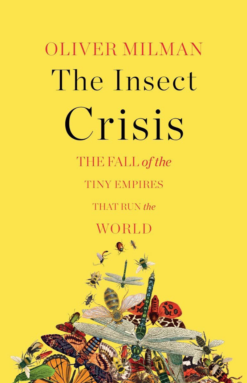The Insect Crisis
Oliver Milman
W.W. Norton & Co., $27.95
Imagine a world without insects. You might breathe a sigh of relief at the thought of mosquito-free summers, or you might worry about how agriculture will function without pollinators. What you probably won’t picture is trudging through a landscape littered with feces and rotting corpses — what a world devoid of maggots and dung beetles would look like.
That’s just a snippet of the horrifying picture of an insect-free future that journalist Oliver Milman paints in the beginning of The Insect Crisis. “The loss of insects would be an agonizing ordeal eclipsing any war and even rivaling the looming ravages of climate breakdown,” he writes. And yet, the threat of an impending “insect apocalypse” doesn’t get nearly the same level of attention as climate change.
Researchers have been observing declining insect populations for decades. For instance, a study of nearly 40 years of data from a protected rainforest in Puerto Rico found that insect biomass had decreased by 98 percent on the ground and 80 percent in the canopy since the mid-1970s.
The threats insects face are many: Light pollution, the increasing use of pesticides and climate change are just a few (SN: 8/31/21; SN: 8/17/16; SN: 7/9/15). And it’s not only rare species that are at risk — it’s also species that were once common around the globe.
The reality of the crisis isn’t as foreboding as Milman initially makes it seem. A world with no insects is unlikely, he acknowledges. Studies have found that while some species are in decline, others, such as freshwater insects, are doing fine (SN: 4/23/20). Rather than viewing the insect crisis as all insect populations on one downward-trending line on a graph, Milman suggests picturing lots of different lines — some holding steady, some sloping up or down, and some zigzagging. “Insects are being shifted to an unhappy state where there will be far more bedbugs and mosquitoes and far fewer bumblebees and monarch butterflies,” he writes.
Those changes in biodiversity come with consequences. Farmers may have to fend off more pests that attack soybeans, for instance, and insect-pollinated fruits and vegetables will become hard to grow at scale. Some insect-eating animals will decline as their food disappears, which has already happened to some birds (SN: 7/11/14), or even vanish. Water and soil quality could also be in jeopardy.
Milman investigates the crisis by sharing his own adventures with insects, along with those of researchers, taking readers from the United States to Mexico, across the Atlantic to Europe and all the way to Australia. By sharing scientists’ stories, he makes the plight of insects personal. There’s a researcher in Denmark who has spent 25 years surveying insect populations by driving his old Ford Anglia down the same country roads and counting the number of bugs squashed against the windshield. Back when he started, he’d regularly have to clean insect guts off his car. But in recent years, he has experienced a lot of “zero insect days.” As I read that, I struggled to remember the last time I had to scrape any dead insects off my car. Another researcher recalls the joy of catching fireflies on his family ranch in Texas as a child. I felt a wave of sadness as I thought about how I don’t see fireflies as much as I did when I was a kid. With more streetlights and the switch to LED bulbs, it’s becoming harder for fireflies to spot potential mates.
Amid the doom and gloom, the book still manages to spark awe and delight with fun facts about insects. Bumblebee wings, for instance, vibrate so fast that they can produce gravitational forces of up to 50 g’s — five times greater than what fighter jet pilots experience. Milman also offers hope, sharing how certain insects are adapting to the threats and how some people are fighting to protect the critters through political campaigns and changing farming habits.
By the book’s end, readers may find that their attitude toward some insects has shifted from loathing to love, or at the very least, appreciation. (I, for one, never cared much for flies — until I learned we wouldn’t have chocolate without them.) Milman makes clear how much we benefit from insects, and what we stand to lose without them. As one researcher puts it, our deeply woven reliance on insects is like the internet: When parts of the network are removed, the less internet there is, “until eventually it doesn’t work anymore.”
A world without the internet would be difficult but livable. The same can’t be said for a world without insects.
Buy The Insect Crisis from Bookshop.org. Science News is a Bookshop.org affiliate and will earn a commission on purchases made from links in this article.




